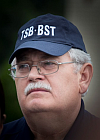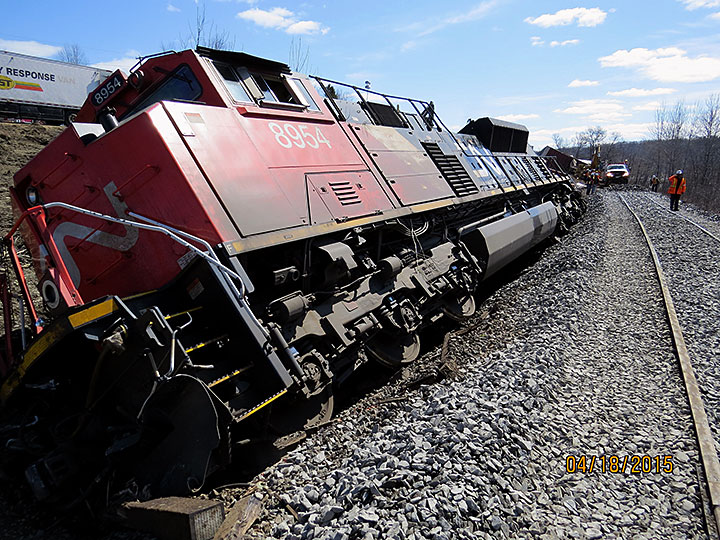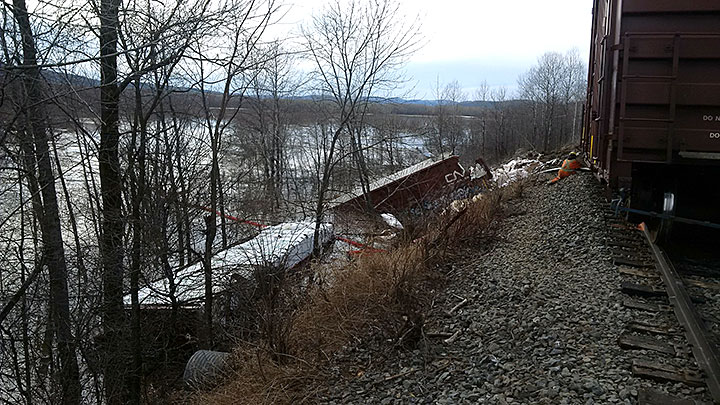Rail transportation safety investigation R15M0034
The TSB has completed this investigation. The report was published on 27 September 2016.
Table of contents
Main-track derailment
Canadian National Railway
Freight train M30511-17
Mile 212.8, Napadogan Subdivision
Saint-Basile, New Brunswick
The occurrence
On , at approximately 1450 Atlantic Daylight Time, westbound Canadian National Railway freight train M30511-17, travelling at 46 mph, derailed 35 rail cars and 1 distributed power locomotive at Mile 212.8 on the Napadogan Subdivision, near Saint-Basile, New Brunswick. The derailment destroyed approximately 900 feet of main track. Twenty of the derailed rail cars were residue tank cars that had last contained crude oil (UN 1267, Class 3). There were no leaks and no injuries.
Media materials
News release
A combination of track conditions and rail wear contributed to April 2015 derailment near Saint-Basile, New Brunswick
Read the news release
Deployment notice
TSB deploys team to CN train derailment in Saint-Basile near Edmundston, New Brunswick
The Transportation Safety Board of Canada (TSB) is deploying a team of investigators to a derailment involving a Canadian National (CN) train in Saint-Basile near Edmundston, New Brunswick. The TSB will gather information and assess the occurrence.
Investigation information
Map showing the location of the occurrence
Investigator-in-charge

Mr. Ross joined the Transportation Safety Board of Canada (TSB) in Hull, Quebec, as a safety analyst in the Accident Prevention Branch. In April 1996, he joined the Investigations Division as a senior investigator. He worked out of the TSB Head Office for 7 years. During this time, he led a number of major rail investigations and often relieved the national manager of investigations, Rail/Pipeline.
In 2000, he started working in Halifax/Dartmouth as the regional senior investigator, Rail/Pipeline for the Atlantic Region. Mr. Ross holds a Certified Health and Safety Consultant designation and a professional Member designation from the Canadian Society of Safety Engineering, and is the national president of Clan Ross Association of Canada. He began his railway career in 1975 at CN Rail’s maintenance shops in Sydney, Nova Scotia. He became a permanent supervisor in 1979, and thereafter occupied a variety of supervisory and management positions across Canada, including in Sydney, Halifax, Moncton, Montreal, Winnipeg and Prince George, British Columbia. His railway experience includes managing car repair shops, locomotive shops, maintenance shops and a wheel shop. Mr. Ross has also worked in CN district, regional and headquarters offices in positions with responsibilities relating to equipment inspection and maintenance (13 transfers in 6 provinces). He has received extensive training in dangerous goods, and was national coordinator of CN’s emergency response teams for over 3 years. He and his wife Caroline have 3 children and 6 grandchildren.
Photos
Download high-resolution photos from the TSB Flickr page.
Class of investigation
This is a class 3 investigation. These investigations analyze a small number of safety issues, and may result in recommendations. Class 3 investigations are generally completed within 450 days. For more information, see the Policy on Occurrence Classification.
TSB investigation process
There are 3 phases to a TSB investigation
- Field phase: a team of investigators examines the occurrence site and wreckage, interviews witnesses and collects pertinent information.
- Examination and analysis phase: the TSB reviews pertinent records, tests components of the wreckage in the lab, determines the sequence of events and identifies safety deficiencies. When safety deficiencies are suspected or confirmed, the TSB advises the appropriate authority without waiting until publication of the final report.
- Report phase: a confidential draft report is approved by the Board and sent to persons and corporations who are directly concerned by the report. They then have the opportunity to dispute or correct information they believe to be incorrect. The Board considers all representations before approving the final report, which is subsequently released to the public.
For more information, see our Investigation process page.
The TSB is an independent agency that investigates air, marine, pipeline, and rail transportation occurrences. Its sole aim is the advancement of transportation safety. It is not the function of the Board to assign fault or determine civil or criminal liability.



